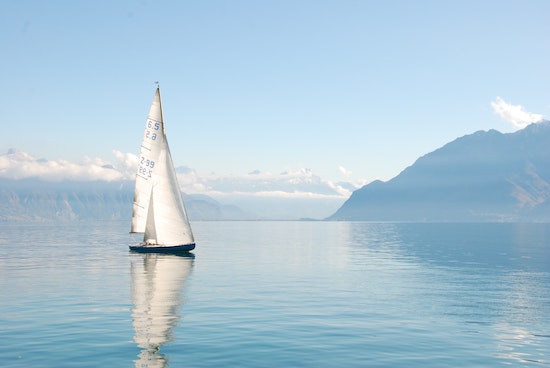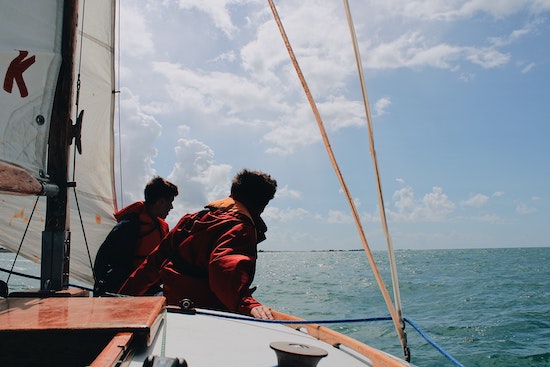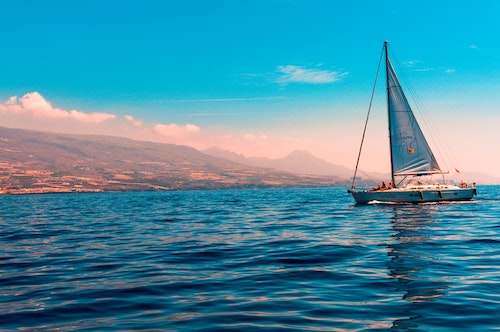If you’ve ever wondered just how fast a sailboat can travel, how to calculate its speed, or what factors can affect its performance, then you’ve come to the right place. We will delve into the exciting world of sailboat speeds, providing you with all the information you need to understand and improve the performance of your own sailboat. So, whether you’re a seasoned sailor or new to the sport, let’s set sail and explore the exciting world of sailboat speeds together.
Introduction

A sailboat is a type of boat that uses the power of the wind to propel itself forward. It is a popular recreational watercraft, as well as a means of transportation and a competitive racing vessel. One of the most common questions people have about sailboats is how fast they can go. The speed of a sailboat can vary depending on several factors, such as the type of sailboat, the wind conditions, and the skill of the person sailing it.
When it comes to the speed of a sailboat, there are a few key factors to consider. Firstly, the type of sailboat can greatly affect its speed. There are various types of sailboats, including dinghies, keelboats, and catamarans, each with their own characteristics and capabilities. For example, a racing catamaran is typically faster than a cruising keelboat. The size and design of the sailboat also play a role in determining its speed.
Another important factor that affects the speed of a sailboat is the wind conditions. The speed and direction of the wind can have a significant impact on how fast a sailboat can travel. Generally, sailboats can achieve their maximum speed when the wind is blowing at an optimal angle and strength. However, if the wind is too strong, it can overpower the sailboat and make it difficult to control. On the other hand, if the wind is too light, the sailboat may struggle to gain speed.
The skill and experience of the person sailing the boat is also crucial in determining its speed. Sailing a boat requires a certain level of knowledge and technique to harness the power of the wind effectively. An experienced sailor will know how to trim the sails and adjust the boat’s course to optimize its speed. Additionally, understanding the principles of sail trim and boat balance can help increase a sailboat’s speed.
How Fast Does a Normal Sailboat Travel?

A normal sailboat can travel at varying speeds depending on various factors. The speed of a sailboat is affected by factors such as wind conditions, the type and size of the sailboat, and the skill of the sailor. Generally, a normal sailboat can travel at an average speed of around 5 to 10 knots (5.75 to 11.5 mph).
One of the key factors that determine the speed of a sailboat is the wind conditions. A sailboat relies on the power of the wind to propel it forward. If there is a strong and steady wind, the sailboat can travel at a faster speed. On the other hand, if the wind is light or inconsistent, the speed of the sailboat will be slower.
The type and size of the sailboat also play a role in determining its speed. Different sailboats have different designs and characteristics that can affect their speed. Some sailboats are designed for speed and have sleek hulls and large sails, allowing them to travel faster. Others may be more suited for stability and comfort rather than speed. Additionally, the size of the sailboat can also impact its speed. Generally, larger sailboats have the potential to reach higher speeds than smaller ones.
- Wind conditions: Strong and steady winds can increase the speed of a sailboat.
- Type and size of the sailboat: The design and size of the sailboat can affect its speed.
- Skill of the sailor: A skilled sailor can optimize the sailboat’s performance and maximize its speed.
How to Calculate the Speed of a Sailboat

Are you a sailing enthusiast who wants to know how to calculate the speed of a sailboat? Whether you are a beginner or an experienced sailor, understanding how to calculate the speed of a sailboat can enhance your overall sailing experience. By knowing the factors that affect sailboat speed and using some simple calculations, you can easily determine how fast your sailboat is traveling on the water. We will walk you through the step-by-step process of calculating the speed of a sailboat.
Step 1: Determine the Distance Traveled
The first step in calculating the speed of a sailboat is to determine the distance it has traveled. You can use various methods to measure the distance, such as using GPS navigation systems or nautical charts. Once you have measured the distance in nautical miles, you are ready to move on to the next step.

Step 2: Measure the Time Taken
| Time | Distance |
|---|---|
| 2 hours | 12 nautical miles |
| 3 hours | 18 nautical miles |
| 4 hours | 24 nautical miles |
The second step involves measuring the time taken by the sailboat to cover the distance. Start a timer or note the time when you begin your journey and stop it when you reach your destination. Make sure to record the time in hours or minutes accurately. For example, if your sailboat took 2 hours to cover 12 nautical miles, note that down for the calculations.
Step 3: Calculate the Speed
Now, it’s time to calculate the speed of the sailboat using the formula: speed = distance/time. By dividing the distance traveled by the time taken, you can determine the speed of your sailboat. Let’s consider an example: if your sailboat covered a distance of 12 nautical miles in 2 hours, the calculation would be as follows: speed = 12 nautical miles / 2 hours = 6 knots. Therefore, your sailboat’s speed is 6 knots.
Calculating the speed of a sailboat is not only useful for keeping track of your sailing journeys but also for understanding the performance of your sailboat. By calculating the speed, you can compare it with the wind speed and direction to optimize your sailing experience. Additionally, it allows you to gauge the efficiency of your sailboat and make necessary adjustments to improve its speed.
Factors Affecting Sailboat Speed

When it comes to sailing, speed is a crucial factor that every sailor wants to maximize. The speed of a sailboat depends on various factors that can either positively or negatively impact its performance on the water. By understanding these factors, sailors can make informed decisions and take appropriate actions to optimize the speed of their sailboats.
One of the key factors influencing the speed of a sailboat is wind conditions. The strength and direction of the wind play a significant role in determining how fast a sailboat can travel. A sailboat will typically achieve its highest speed when sailing with a favorable wind direction, known as a downwind or broad reach. On the other hand, when sailing against the wind, called sailing upwind or close-hauled, the boat’s speed will be reduced as it has to sail at an angle to the wind, which creates more resistance.
Another factor that affects sailboat speed is the design and size of the sailboat. The shape and size of the sails, as well as the overall design of the boat, impact its ability to catch and harness the wind efficiently. A well-designed sailboat with properly trimmed and maintained sails will have better aerodynamics and therefore, improved speed. Additionally, the weight and buoyancy of the sailboat’s hull can also influence its speed. Lighter sailboats tend to be faster as they have less drag in the water.
- The skill and experience of the sailor also play a significant role in determining sailboat speed. A skilled sailor who understands how to effectively trim the sails, adjust the boat’s rigging, and maneuver the boat can optimize its performance and achieve higher speeds. Properly tuning the sailboat’s rigging, such as adjusting the tension of the rigging wires and the angle of the sails, can help reduce drag and improve speed.
- In addition, the water conditions can impact sailboat speed. Factors such as waves, currents, and tides can either assist or hinder the boat’s progress. Favorable currents and tides can provide an extra boost to the sailboat’s speed, while strong opposing currents can significantly slow it down. Similarly, choppy or rough waters can create resistance and result in reduced speed.
- Maintenance and boat condition are also crucial factors affecting sailboat speed. Regular maintenance of the boat’s hull, sails, and rigging ensures that the boat is in optimal condition to maximize speed. Damaged or worn-out sails, improperly functioning rigging, or a hull in need of repair can all negatively impact the sailboat’s performance. Regularly cleaning the hull and keeping it free from marine growth also helps reduce drag and improve speed.
Achieving maximum sailboat speed is a multifaceted endeavor. Sailors must take into account wind conditions, sailboat design, skill, water conditions, and maintenance to optimize the performance of their sailboats. By paying attention to these factors and making necessary adjustments, sailors can enhance their sailing experiences and enjoy the thrill of fast and exhilarating journeys on the open water.
Tips to Improve Speed of a Sailboat

When it comes to sailing, speed is always a desirable aspect. A faster sailboat not only ensures more efficient travel, but also adds to the thrill and excitement of the experience. Whether you are a seasoned sailor or just starting out, there are several tips and techniques that can help you improve the speed of your sailboat. We will explore some of these strategies and discuss how they can make a significant difference in your sailing adventures.
1. Optimize Your Sail Trim: One of the most essential factors that affect the speed of a sailboat is its sail trim. Properly adjusting the sails according to the wind conditions is crucial for achieving maximum efficiency. Make sure the sails are not too loose or too tight, and adjust the angle of the sail to harness the power of the wind effectively. Keeping an eye on your sail trim and making necessary adjustments will greatly improve your sailboat’s speed.
2. Reduce Drag: Another important aspect to consider when it comes to improving sailboat speed is to minimize drag. Drag can significantly slow down a sailboat, reducing its overall performance. To reduce drag, keep the hull and bottom of the boat clean and free from any debris or marine growth. Additionally, make sure that all movable parts, such as hinges and fittings, are well lubricated and in good condition to minimize any unnecessary resistance.
3. Utilize the Power of the Wind: The wind is the driving force behind the speed of a sailboat. To make the most of this natural resource, it is essential to understand the wind patterns and utilize them to your advantage. For example, sailing at a close reach or a broad reach allows the sailboat to capture more wind and increase its speed. Additionally, knowing how to properly trim the sails to match the wind direction will help you optimize your sailboat’s performance.
| Pros | Cons |
|---|---|
| Improved efficiency | Requires practice and skill |
| Enhanced sailing experience | Dependent on wind conditions |
| Faster travel times | Requires regular maintenance |
In conclusion, improving the speed of a sailboat requires a combination of skill, knowledge, and attention to detail. By optimizing your sail trim, reducing drag, and utilizing the power of the wind, you can enhance your sailboat’s performance and enjoy faster travel times on the water. However, it is important to keep in mind that sailing speed is also dependent on external factors such as wind conditions and maintenance. By implementing these tips and techniques, you can make your sailing adventures more enjoyable and exhilarating.




